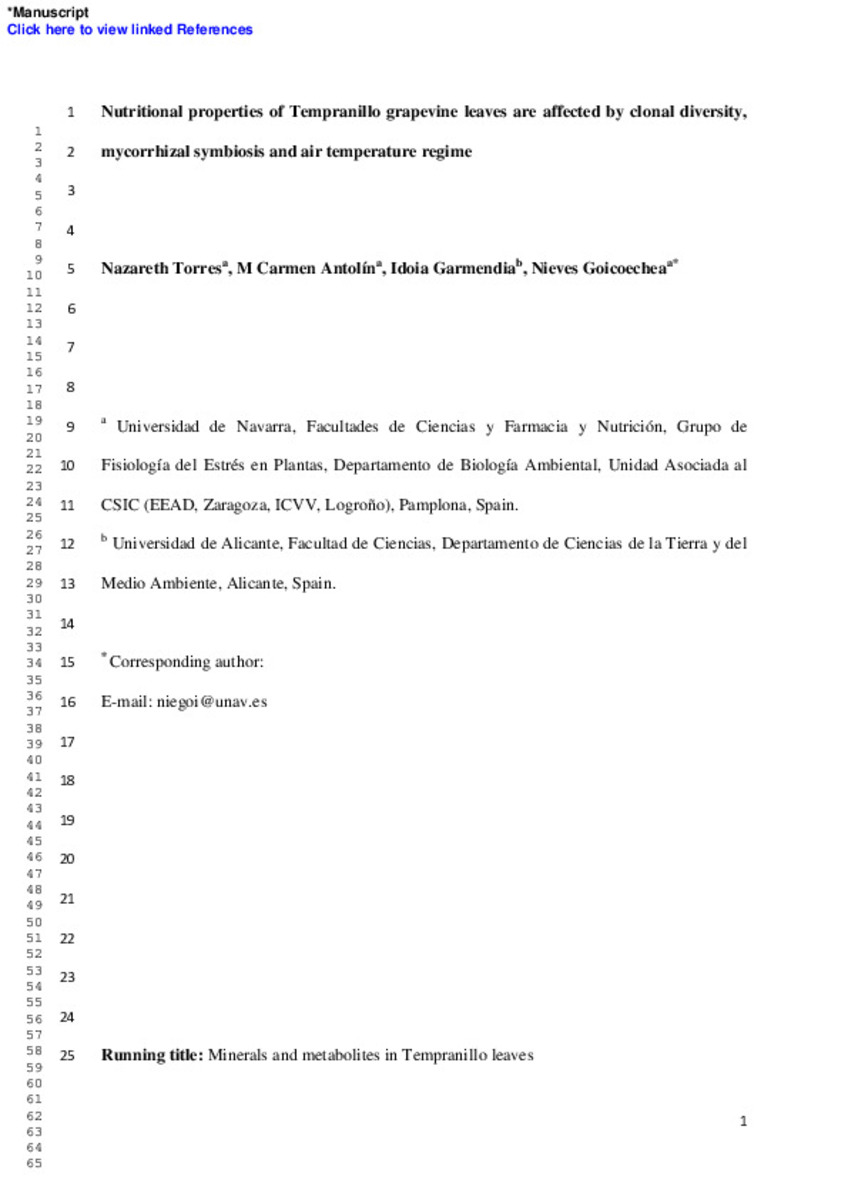Full metadata record
| DC Field | Value | Language |
|---|---|---|
| dc.creator | Torres, N. (Nazareth) | - |
| dc.creator | Antolin-Bellver, M.C. (M. Carmen) | - |
| dc.creator | Garmendia, I. (Idoia) | - |
| dc.creator | Goicoechea, N. (Nieves) | - |
| dc.date.accessioned | 2023-12-18T14:11:07Z | - |
| dc.date.available | 2023-12-18T14:11:07Z | - |
| dc.date.issued | 2018-09 | - |
| dc.identifier.citation | Torres N, Antolín MC, Garmendia I, Goicoechea N. Nutritional properties of Tempranillo grapevine leaves are affected by clonal diversity, mycorrhizal symbiosis and air temperature regime. Plant Physiol Biochem. 2018 Sep;130:542-554. | es_ES |
| dc.identifier.issn | 0981-9428 | - |
| dc.identifier.uri | https://hdl.handle.net/10171/68083 | - |
| dc.description.abstract | Tempranillo grapevine is widely cultivated in Spain and other countries over the world (Portugal, USA, France, Australia, and Argentina, among others) for its wine, but leaves are scarcely used for human or animal nutrition. Since high temperatures affect quality of fruits and leaves in grapevine and the association of Tempranillo with arbuscular mycorrhizal fungi (AMF) enhances the antioxidant properties of berries and leaves, we assessed the effect of elevated air temperature and mycorrhization, separately or combined, on the nutritional properties of Tempranillo leaves at the time of fruit harvest. Experimental assay included three clones (CL-260, CL-1048, and CL-1089) and two temperature regimes (24/14 °C or 28/18 °C day/night) during fruit ripening. Within each clone and temperature regime there were plants not inoculated or inoculated with AMF. The nutritional value of leaves increased under warming climate: elevated temperatures induced the accumulation of minerals, especially in CL-1089; antioxidant capacity and soluble sugars also increased in CL-1089; CL-260 showed enhanced amounts of pigments, and chlorophylls and soluble proteins increased in CL-1048. Results suggested the possibility of collecting leaves together with fruit harvest with different applications of every clone: those from CL-1089 would be adequate for an energetic diet and leaves from CL-260 and CL-1048 would be suitable for culinary processes. Mycorrhization improved the nutritional value of leaves by enhancing flavonols in all clones, hydroxycinnamic acids in CL-1089 and carotenoids in CL-260. | es_ES |
| dc.description.sponsorship | This work was supported by Spanish Ministry of Economy and Competency (AGL2014-56075-C2-1-R), INNOVINE European project (INNOVINE 311775) and University of Alicante (UAUSTI14-05). Authors thank H. Santesteban and A. Urdiáin for their help in the design, setup and maintenance of the experimental facilities, and M. Oyarzun, R. Brau and A. Cabodevilla for their assistance during measurements. N. Torres was the recipient of a FPU grant of the Spanish Ministry of Education, Culture and Sport. | es_ES |
| dc.language.iso | eng | es_ES |
| dc.publisher | Elsevier | es_ES |
| dc.rights | info:eu-repo/semantics/openAccess | es_ES |
| dc.subject | Arbuscular mycorrhizal fungi | es_ES |
| dc.subject | Global warming | es_ES |
| dc.subject | Minerals | es_ES |
| dc.subject | Phenolic compounds | es_ES |
| dc.subject | Pigments | es_ES |
| dc.subject | Vitis vinifera cv. Tempranillo | es_ES |
| dc.title | Nutritional properties of Tempranillo grapevine leaves are affected by clonal diversity, mycorrhizal symbiosis and air temperature regime | es_ES |
| dc.type | info:eu-repo/semantics/article | es_ES |
| dc.identifier.doi | 10.1016/j.plaphy.2018.08.004 | - |
| dc.identifier.pmid | 30098586 | - |
Files in This Item:
Statistics and impact
Items in Dadun are protected by copyright, with all rights reserved, unless otherwise indicated.






